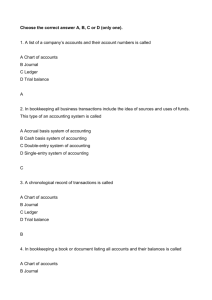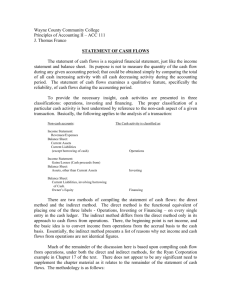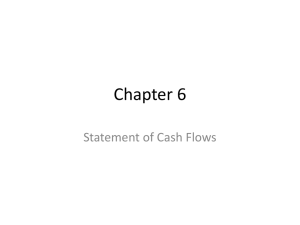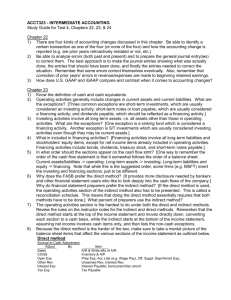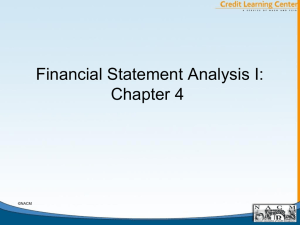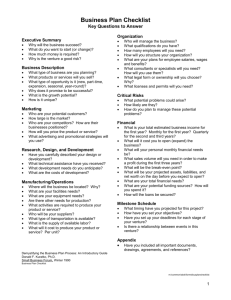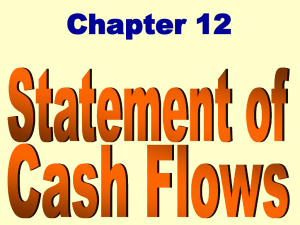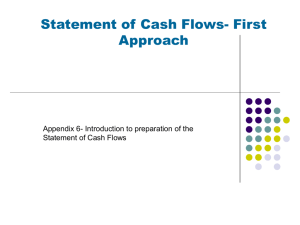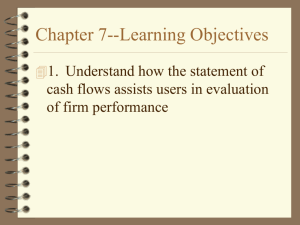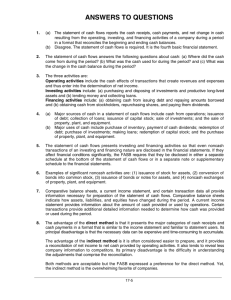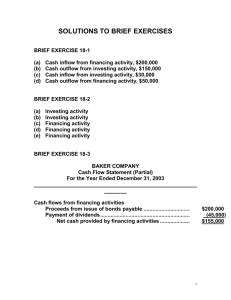theme: cash flow - Real Life Accounting
advertisement
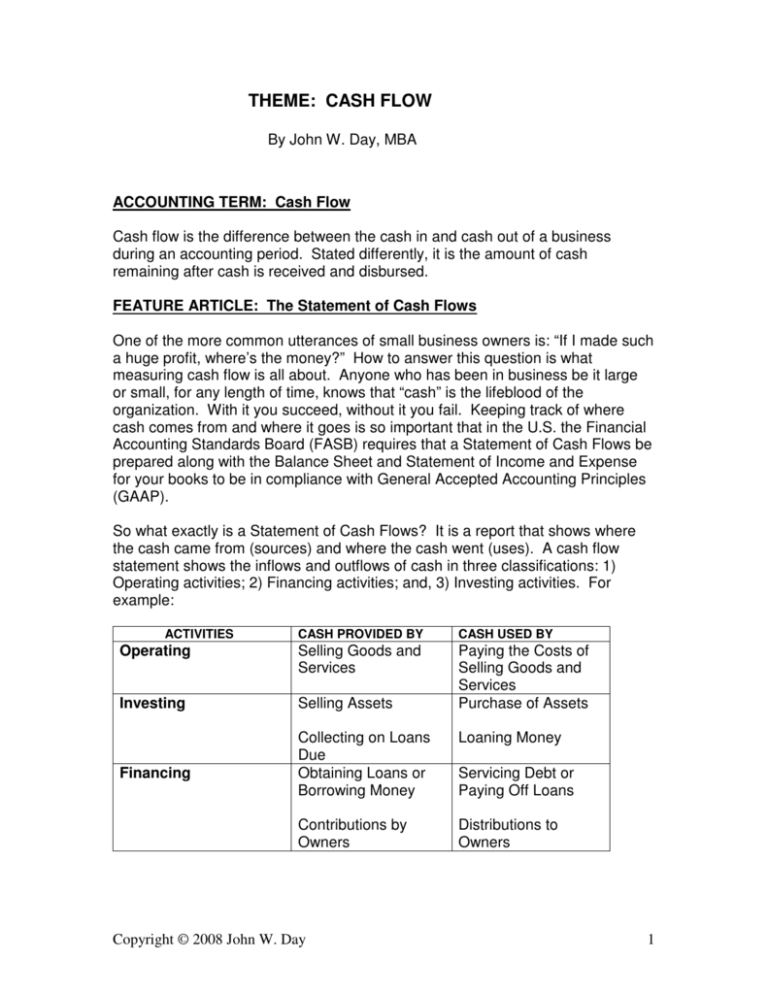
THEME: CASH FLOW By John W. Day, MBA ACCOUNTING TERM: Cash Flow Cash flow is the difference between the cash in and cash out of a business during an accounting period. Stated differently, it is the amount of cash remaining after cash is received and disbursed. FEATURE ARTICLE: The Statement of Cash Flows One of the more common utterances of small business owners is: “If I made such a huge profit, where’s the money?” How to answer this question is what measuring cash flow is all about. Anyone who has been in business be it large or small, for any length of time, knows that “cash” is the lifeblood of the organization. With it you succeed, without it you fail. Keeping track of where cash comes from and where it goes is so important that in the U.S. the Financial Accounting Standards Board (FASB) requires that a Statement of Cash Flows be prepared along with the Balance Sheet and Statement of Income and Expense for your books to be in compliance with General Accepted Accounting Principles (GAAP). So what exactly is a Statement of Cash Flows? It is a report that shows where the cash came from (sources) and where the cash went (uses). A cash flow statement shows the inflows and outflows of cash in three classifications: 1) Operating activities; 2) Financing activities; and, 3) Investing activities. For example: CASH PROVIDED BY CASH USED BY Operating ACTIVITIES Selling Goods and Services Investing Selling Assets Paying the Costs of Selling Goods and Services Purchase of Assets Financing Collecting on Loans Due Obtaining Loans or Borrowing Money Loaning Money Contributions by Owners Distributions to Owners Copyright © 2008 John W. Day Servicing Debt or Paying Off Loans 1 In a nutshell, all one has to do is figure out the net cash flow from each of the activities, add them together to arrive at a summary of the three activities, then add or subtract that number, depending on whether it is a positive or negative number, to Cash at the beginning of the accounting period (month, year, etc.). The resulting amount should match the ending cash balances found on your Balance Sheet for the period. To illustrate: Net Cash Flow from Operating Activities $100 Net Cash Flow from Investing Activities $200 Net Cash Flow from Financing Activities $300 Net Increase in Cash $600 Cash at the beginning of the period $100 Cash at the end of the period $700 ==== Reconciled cash balances at end of period $700 ==== This is known as the Direct Method cash flow statement. This approach is fairly straight-forward except that you have to make sure to properly categorize the cash inflow and outflow accounts according to the three activities. With the Statement of Cash Flows, you will know exactly where your money came from and where it went. On the other hand, as a small business owner, do you need the Statement of Cash Flows? Certainly, it can be a very useful report. But is it worth the money to have your accountant prepare it? Of course, only you can answer that question. If your business is so small that you know without much effort where the cash came from and went, then you probably don’t need one, unless your financial statements are being prepared according to GAAP. QUESTION: Is There Only One Method For Preparing A Statement Of Cash Flows? No, there are two acceptable methods, the Direct Method and the Indirect Method. The Indirect Method is sort of a “backdoor” approach, but it works just fine. It is still organized from the standpoint of the three activities: Operating; Investing; and, Financing. However, the big difference is the way in which the net cash Operating activity is determined. Copyright © 2008 John W. Day 2 For example, the starting point for the Indirect Method is with Net Income. Since Net Income includes non-cash items, they have to be adjusted to arrive at a figure that is purely cash. There are three types of adjustments to be made: 1) Adjusting from accrual to cash basis. These will involve adding to Net Income decreases in Accounts Receivable, Inventories, and prepaid expenses, and increases in Accounts Payable and accrued expenses. Increases in Accounts Receivable, Inventories, and prepaid expenses, and decreases in Accounts Payable and accrued expenses will be deducted from Net Income. 2) Eliminating non-cash transactions. Depreciation and Amortization will be added to Net Income. 3) Eliminating non-operating items. Losses on sales of Fixed Assets will be added back to Net Income. Gains on such sales will be deducted from Net Income. To clarify what this means, a net increase in the Accounts Receivable balance indicates there are non-cash sales included in the Net Income balance that must be subtracted. A net increase in Accounts Payable indicates some non-cash expenses causing Net Income to be lower. Therefore, an increase or addition to Net Income is required. Depreciation is a non-cash expense therefore requiring an increase to Net Income. There is no question that this process can become quite confusing because you have to think in terms of how certain accounts have a reverse effect on Net Income. Fortunately, many accounting software programs now produce a Statement of Cash Flows. However, the report will be worthless unless the accounts are properly identified under the three categories of activities: Operating; Investing; and, Financing. Using an oversimplified illustration, you can see what a Statement of Cash Flows might look like using the Indirect Method: Cash flow from Operating activities: Net Income $1,000 Adjustments to reconcile Net Income to net cash provided by operating activities: Depreciation Increase in Accounts Receivable Increase in Inventory Increase in Accounts Payable Copyright © 2008 John W. Day 100 <700> <900> 600 3 Net cash provided by operating activities $ 100 Cash flow from Investing activities $ 200 Cash flow from Financing activities $ 300 Net Increase in Cash $ 600 Cash at the beginning of the period $ 100 Cash at the end of the period $ 700 ====== $ 700 ====== Reconciled Cash balances end of period Either method brings the same result, as it must. The Indirect Method offers more detail as to the cash flow of the Operating activities. Learning how to prepare a manual Statement of Cash Flows can be a challenge, yet, once learned, will solve the mystery of where your money went. TIP: A Quick And Dirty Cash Flow Analysis Let’s face it, if you are a small business operator who is struggling to make ends meet, you are not going to want to spend the money or the time to prepare a Statement of Cash Flows if it is not required. All you really want to do is get a general idea of where the cash came from and where it was spent. So if you don’t have to have the cash reconciled down to the penny, here is a quick and dirty method to get a handle on your cash flow. First you must grasp the general concept of the Indirect Method as described above. Start with Net Income, as most of it is probably cash. Add back your Depreciation or Amortization expense immediately because that’s easy. Next, adjust for any accruals such as Accounts Receivable, Accounts Payable, or Payroll Taxes Payable. If you happen to have any gains or losses from the disposition of assets, then add back the losses or subtract the gains. Once this is done, go the Balance Sheet and look at the accounts that may have caused an increase in cash other than from sales activities. Start at the top of the Balance Sheet and work your way down each account. Your first account to review will be Cash. Has the balance increased or decreased since the beginning of the year? If the Cash account balance is less than last year’s balance that will mean that you used some of last year’s cash for this year’s disbursements. You will have to add that amount to your adjusted Net Income balance. Did you borrow any money this year? If so, add the amount to your total. Do you have a Sales Tax Payable figure that is higher than at the beginning of the year? If so, add that amount because you collected cash from Copyright © 2008 John W. Day 4 customers but have not yet paid the tax. Did you contribute any money to the business this year? These are all sources of cash. Add them together because this is the amount of cash you are trying to account for. Now where did the money go? Start back at the top of the Balance Sheet and keep working your way down. Is there more cash in your bank account than you started with at the beginning of the year? If so, the increase accounts for some of your cash. Did your Inventory increase over last year? If so, did you pay cash? It the answer is yes, then there is some more of your money. Remember, you have to think in terms of whether the balance in the accounts had a net increase or decrease from the beginning of the year. Then you must think out whether that means an increase or decrease in cash. Did you buy any Fixed Assets during the year? This might mean a decrease in cash. Is Sales Tax Payable lower than last year? If so, then you used some cash to pay it. Did you pay down the principal of some old Notes Payable? If so, that means a decrease in cash. Don’t miss any distributions to the owner, such as in the Owner’s Draw account. How much did you pay yourself? Add all these uses of cash and compare them with your sources total. The idea is for the sources and uses of cash to be somewhat close, enough anyway for you to feel satisfied that no money has gone missing. If the sources and uses of cash are not close after applying the quick and dirty method, at least you will know that you better dig in and find out why. John W. Day, MBA is the author of two courses in accounting basics: Real Life Accounting for NonAccountants (20-hr online) and The HEART of Accounting (4-hr PDF). Visit his website at http://www.reallifeaccounting.com to download his FREE e-book pertaining to small business accounting and his monthly newsletter on accounting issues. Ask John questions directly on his Accounting for NonAccountants blog. Copyright © 2008 John W. Day 5
